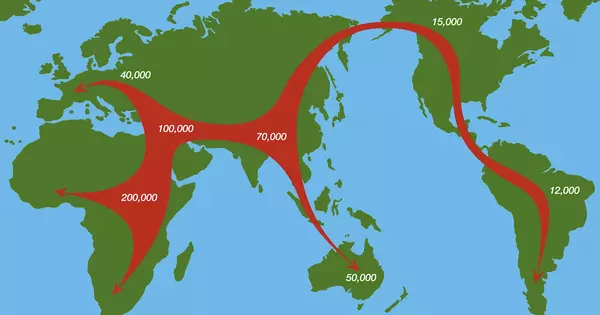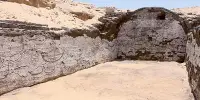Ancient DNA analysis is a powerful tool that can provide insight into the genetic makeup and migration patterns of ancient populations. In the case of South America, genetic studies of ancient human remains have revealed that the initial peopling of the continent likely occurred around 15,000 years ago, when people from North America crossed the Bering Strait land bridge and migrated southward. These first South American inhabitants were likely part of the Clovis culture, known for their distinctive fluted stone projectile points. Further migrations and gene flow from other populations likely occurred in the millennia that followed.
Researchers have uncovered the deep demographic history of South America at the regional level using DNA from two ancient humans discovered in two different archaeological sites in northeast Brazil, with some surprising results. They have discovered migrations in the opposite direction along the Atlantic coast for the first time, not only providing new genetic evidence to support existing archaeological data of the north-to-south migration toward South America. Among the key discoveries, they discovered evidence of Neanderthal ancestry within the genomes of ancient South American individuals.
The Americas were the last continents to see human settlement. A growing body of archaeological and genomic evidence suggests a complicated settlement process. This is especially true for South America, where unexpected ancestral signals have raised perplexing scenarios for the continent’s early migrations.
Many questions remain unanswered, such as whether the first humans migrated south along the Pacific coast or by another route. While there is archaeological evidence for a north-to-south migration of ancient Indigenous peoples during the initial peopling of the Americas, where these ancient humans went after they arrived has remained a mystery.
Our study provides key genomic evidence for ancient migration events at the regional scale along South America’s Atlantic coast. These regional events likely derived from migratory waves involving the initial Indigenous peoples of South America near the Pacific coast.
Michael DeGiorgio
Using DNA from two ancient human individuals discovered in two different archaeological sites in northeast Brazil – Pedra do Tubaro and Alcobaça – as well as powerful algorithms and genomic analyses, Florida Atlantic University researchers collaborated with Emory University to unravel the deep demographic history of South America at the regional level, yielding some unexpected and surprising results.
Researchers have discovered migrations in the opposite direction along the Atlantic coast for the first time, in addition to providing new genetic evidence to support existing archaeological data of the north-to-south migration toward South America. The study provides the most comprehensive genetic evidence for a complex ancient Central and South American migration route to date.
Among the major discoveries, researchers discovered evidence of Neanderthal ancestry in the genomes of ancient South Americans. The Neanderthals were an extinct population of archaic humans who roamed Eurasia during the Lower and Middle Paleolithic periods.
According to the study’s findings, which were published in the journal Proceedings of the Royal Society B. (Biological Sciences), human movements closer to the Atlantic coast eventually linked ancient Uruguay and Panama in a south-to-north migration route that was 5,277 kilometers (3,270 miles) apart. Based on the ages of the ancient individuals, this novel migration pattern is thought to have occurred around 1,000 years ago.

Findings show a distinct relationship among ancient genomes from northeast Brazil, Lagoa Santa (southeast Brazil), Uruguay, and Panama. This new model reveals that the settlement of the Atlantic coast occurred only after the peopling of most of the Pacific coast and Andes.
“Our study provides key genomic evidence for ancient migration events at the regional scale along South America’s Atlantic coast,” said Michael DeGiorgio, Ph.D., the co-corresponding author who specializes in human, evolutionary, and computational genomics and is an associate professor in the Department of Electrical Engineering and Computer Science within FAU’s College of Engineering and Computer Science. “These regional events likely derived from migratory waves involving the initial Indigenous peoples of South America near the Pacific coast.”
Researchers also found strong Australasian (Australia and Papua New Guinea) genetic signals in an ancient genome from Panama.
“We still don’t know how these ancestral genomic signals appeared in Central and South America without leaving traces in North America,” said Andre Luiz Campelo dos Santos, Ph.D., first author, archaeologist, and postdoctoral fellow in FAU’s Department of Electrical Engineering and Computer Science.
Researchers discovered more Denisovan than Neanderthal ancestry in ancient Uruguay and Panama individuals, adding to the already complex picture. Denisovans are a group of extinct humans discovered in 2008 using DNA sequences from the tip of a finger bone.
“It’s phenomenal that Denisovan ancestry made it all the way to South America,” says John Lindo, Ph.D., a co-corresponding author of the article who specializes in ancient DNA analysis and is an assistant professor in the Department of Anthropology at Emory University. “The admixture must have occurred a long time before, perhaps 40,000 years ago. The fact that the Denisovan lineage persisted and its genetic signal made it into an ancient individual from Uruguay that is only 1,500 years old suggest that it was a large admixture event between a population of humans and Denisovans.”
Previously, at the Federal University of Pernambuco in Recife, Brazil, dos Santos and colleagues discovered the remains of two ancient humans from northeast Brazil dating back at least 1,000 years before present and sent them to Lindo for DNA extraction and subsequent genomic sequencing and analyses. The raw data were then sent to FAU for computational analysis of the whole genome sequences from northeast Brazil.
Researchers compared the two newly sequenced ancient whole genomes from northeast Brazil to modern global genomes and other ancient whole genomes from the Americas. Lindo claims that only a dozen or so ancient whole genomes from South America have been sequenced and published as of the article’s publication date, compared to hundreds from Europe.















